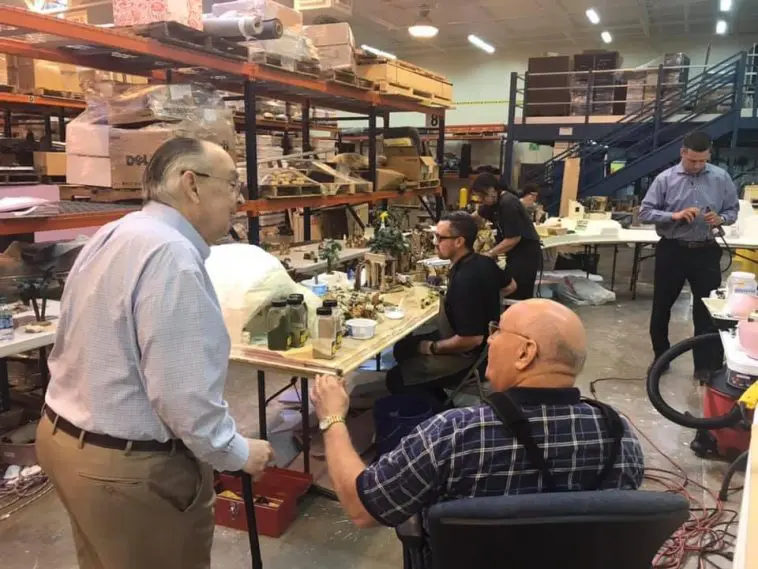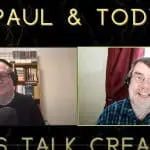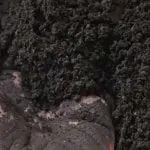[Originally published as Giants]
Dr. Henry M. Morris III checking on the progress of the Life of Christ Diorama. The beautiful bald head belongs to the author.
For I delivered unto you first of all that which I also received, how that Christ died for our sins according to the scriptures; And that he was buried, and that he rose again the third day according to the scriptures: 1 Corinthians 15:3-4)
The Institute for Creation Research (ICR) opened the Discovery Center for Science and Earth History (DC) on Labor Day, 2019. As the year kicked off, the final touches were being added, tweaked, and polished before the big opening day.
The previous year, a wealthy donor presented ICR with his extensive collection of biblical figurines depicting the life of Christ. The collection included thousands of figurines, buildings, and miscellaneous accent pieces. The leadership of ICR decided that they wanted to take what was given and create a “Life of Christ” diorama which would be displayed at the end of the Discovery Center exhibit hall. The diorama would be across from the Empty Tomb display and occupy the corner leading to the “Return of the King” theater.
Because space would be limited, the entire collection of figurines and buildings could not be used, so the decision was made to limit the display to 16 significant scenes of the life of Christ. Once the scenes were determined, Dr. Henry M. Morris III, CEO of ICR at that time, tasked me with finding artisans who could create the diorama.
I got to work contacting all the railroad modeling clubs around the Dallas-Fort Worth metroplex. Because these clubs are experienced in creating scenery for their railroad displays, I naturally assumed that they would jump at the chance to create something significant and make some serious money for their clubs. ICR would naturally pay a fair wage for their work. However, after several months of making contacts, I hadn’t gotten a single nibble.
In the process, I located a man who was willing to do the work, but he was a “one-man-band.” He said he could certainly do the work, but he could not possibly complete the task in time for the opening of the Discovery Center. Another man was recommended to me by one of my co-workers, but this man looked at our collection and determined that the project was beneath his artistic talents.
Finally, I stumbled across a company in Dallas that specialized in these kinds of displays. Their representative came and looked at our collection and after a couple of weeks came back with an estimate to do the job. This company employed a large team of artisans. Even with their large crew, they could not promise completion until the middle of August — two weeks before opening day. Their estimate for the job was a shocking $175,000! ICR is an NPO that exists through the generosity of its donors, so the price was completely unacceptable to Dr. Morris.
It was mid-March 2019 by this time, and I was out of options.
Dr. Morris previously mentioned that he wanted each scene in the diorama to stand alone as distinct and easily identifiable. Having no other options, I went to Dr. Henry and made a final suggestion. Since the room where the diorama would reside was painted black and the platform on which it would sit was black, I suggested that we arrange boxes of varying heights and sizes to accommodate the 16 scenes and cover the whole thing with black cloth. The scenes could then be arranged on the boxes and all spotlighted. This way, each scene would be isolated without distracting one from another. It was not a great idea, but it seemed that we had no other choice, so Dr. Henry accepted my lame idea.
The following week, I left for California for a conference. When I returned a week later, Dr. Henry called me into the office and informed me that the box idea was out and that I would be creating the diorama.
“I can’t do that!” I complained. “I’ve never worked with that material. I wouldn’t know where to begin!” I whined.
“You can do it,” Dr. Henry assured me. “You built the Ark!” (Which is on display in the Discovery Center.)
“Yes,” I reminded him, “but that took me five years! And we only have four months to get this done. Even the professionals said they can’t get it done in that time.”
“You will do it,” Dr. Herny reassured me, “but it needs to be completed by the end of June when we will begin giving previews to our donors.”
I was not so sure, but Dr. Henry assured me that I could recruit all the help I needed to get the job done. I learned that one of my co-workers (JK) had dabbled in railroad modeling and had built several railroad dioramas. He knew how to use the materials for building dioramas. I recruited him as my primary helper. His supervisor objected severely to me taking him away from his primary responsibility, but Dr. Herny overruled his objection. JK not only knew exactly what to do, but he taught me many of the skills needed to get the job done.
One of the challenges we faced was making the figurines appear to be standing on solid ground. The figurines were made to stand on a tabletop, so they were all molded standing on pedestals. That, of course, would be distracting when they were to be placed on “turf.” We built the landscape by stacking Styrofoam insulation of varying thicknesses to sculpt the Judean topography. So, we carved holes into the foam of the size and depth of the figurine pedestals and set the figurines into the carved-out spaces so that their feet were at “ground level” with the topography. Once the turf material was applied, the pedestals disappeared. (See below.)

Another challenge I faced was that the collection came with a “Temple” that was clearly of Greco-Roman architecture, incompatible with the Jewish Temple, so I cast that aside and built a Temple replica that looked more like the Jewish Temple. Once the diorama was completed and in place, I discovered that the graphics created for kiosks in front of the diorama contained images of the Temple that looked almost exactly like the replica I built. That was totally a God thing!

I had a lot of help in building the diorama, so I cannot take full credit for it. JK possessed excellent skills and had a good eye for detail. One lady (KM) was highly artistic and re-painted many of the figurines to make them look more Middle Eastern (they were all European-looking figurines). She painted the Temple and many of the buildings to look like Jerusalem limestone. She painted a lot of exposed rock formations as well. KM did terrific work!
Another lady (RB) was great at following directions and did not mind getting her hands dirty. She staged the figurines in the proper positions for the scene. However, the One who did the greatest work was God. We started the work about mid-April, completed the entire project, and installed it in place by the middle of June. That was a miracle only God could perform. The professionals with a team of professional artists could not promise the completion in time for opening day, and here, a bunch of amateurs got it done with time to spare. That is a God thing!


I retired from ICR at the end of the year the Discovery Center opened. In my retirement, I had the opportunity to volunteer as a docent from time to time. It always gave me a great sense of satisfaction to observe visitors as they scrutinized the diorama. They took in every detail!
I live far from the Discovery Center now, so I do not have the opportunity to visit anymore. But as I remember the work we did to get it up and running, I am reminded of what God can do through us when we place our trust in Him for the outcome. “Trust in the LORD with all thine heart; and lean not unto thine own understanding. In all thy ways acknowledge him, and he shall direct thy paths” (Proverbs 3:5–6).
I received the picture at the beginning of this post this week from Dr. Henry’s son, H-4. It revived a lot of good memories.







